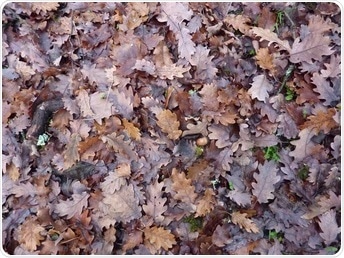Researchers have shed new light on the association between the diversity of plants in forests and the diversity of microorganisms, like fungi and bacteria, involved in their decay.

Leaf litter. Image Credit: Léa Beaumelle.
The decomposition of plant litter is a key ecosystem function, connecting plant biomass to carbon stocks in the atmosphere and soil, and discharging nutrients such as phosphorus and nitrogen that have an impact on the biodiversity of soil.
Two latest independent studies have reported how the biodiversity of plants affects the decomposition processes and how it could help estimate the potential loss of species and their impact on the forest ecosystems. The two studies were recently published in the eLife journal.
For the first study, scientists from China and France examined the association between the diversity of plant litter and its decomposition over 65 field studies conducted in forests worldwide.
According to the study results, the decomposition of plants is faster when litter is made up of more than one species. This was specifically evident in forests with mild temperatures, but was more variable in other forest settings.
We also found that plant diversity accelerated the release of nitrogen, but not phosphorus, potentially indicating a shift in ecosystem nutrient limitation caused by a change in biodiversity. This discovery was again clear for temperate forests, but still needs confirmation for boreal, Mediterranean, subtropical and tropical forests that are currently limited on data.”
Liang Kou, Study Co-First Author and Associate Professor, Institute of Geographic Sciences and Natural Resources Research, Chinese Academy of Sciences
Huimin Wang added, “Our results suggest that biodiversity loss will modify carbon and nutrient cycling in forest ecosystems.”
The potential impact of changes in litter diversity on carbon and nutrient cycling warrants particular attention in future studies, which would ideally integrate responses from decomposers for a better understanding of changes in carbon and nutrient cycling and the mechanisms driving them.”
Huimin Wang, Study Co-Senior Author and Professor, Institute of Geographic Sciences and Natural Resources Research, Chinese Academy of Sciences
The second study published in the eLife journal, performed by scientists from Germany and Belgium, points out the significant connections between decomposer diversity and plant litter, as well as demonstrates how these connections can be affected by human activity.
Industrial and agricultural activities can have detrimental effects on decomposer organisms. They release chemical stressors such as metals and pesticides, as well as nutrients, into soil and water. Chemical stressors and added nutrients modify decomposer communities by affecting their diversity, abundance and metabolism.”
Léa Beaumelle, Study First Author and Postdoctoral Researcher, German Centre for Integrative Biodiversity Research Halle-Jena-Leipzig, University of Leipzig
Earlier experiments performed under simple conditions have demonstrated that loss of biodiversity has adverse impacts on ecosystem processes. However, it is still unclear how these outcomes apply to real-world situations of changes in biodiversity.
Therefore, the scientists set out to find whether the responses of the decomposition of plant litter to chemical stressors and the added nutrients can be described by modifications in the decomposer diversity across ecosystems.
To achieve this, the researchers examined the outcomes of 69 independent research works that reported as many as 660 observations of the impacts of nutrient enrichment or chemical stressors on microbial and animal decomposers and the decomposition of plant litter.
The team observed that a decline in the abundance and diversity of decomposers explained the rates of reductions in plant decay under the effect of chemical stressors, but not the added nutrients. This implies that human activities reduce decomposer biodiversity, which subsequently causes considerable effects on the functions of the ecosystem.
Nico Eisenhauer, the study’s senior author, stated, “These findings could inform the design of suitable strategies to maintain biodiversity and ecosystem functioning.”
Eisenhauer is also the Head of Experimental Interaction Ecology at the German Centre for Integrative Biodiversity Research (iDiv) Halle-Jena-Leipzig, University of Leipzig.
“But they also show that these strategies must take human activities into account and cannot rely solely on improving biodiversity alone,” Eisenhauer concluded.
Source:
Journal reference:
Kou, L., et al. (2020) Diversity-decomposition relationships in forests worldwide. eLife. doi.org/10.7554/eLife.55813.